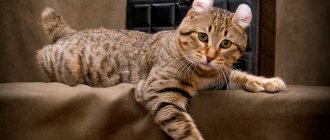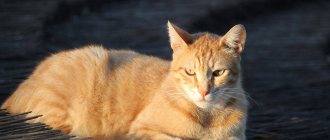Burmilla cat is an alternative name for the Burmese silver breed. This aristocratic breed originated in Great Britain quite recently - only thirty years ago, and quite by accident. The Burmilla cat breed received official recognition in 1989.
The Burmilla is distinguished by its beautiful, sophisticated appearance and gentle character, which makes the cat an ideal pet for a family with other pets and small children.
History of the origin of the breed
The story begins in the eighties of the last century in Foggy Albion. Baroness Miranda von Kirchberg kept cats in large numbers; Persian and Burmese cats, which the woman actively bred, were especially held in high esteem.
The Burmilla cat breed appeared on its own and completely unexpectedly: due to the negligence of a maid who forgot to lock the door to the cages of two cats. One is a Persian chinchilla cat Sunquist, the other is a Faberge Burmese tortoiseshell cat.
By pure chance, this feline couple gave birth to four kittens. They looked charming, having inherited the distinctive features of both breeds and the beautiful silver color.
Later, these kittens were crossed with Burmese - and this is how the Burmilla cat breed appeared, recognized by international organizations within a few years.
Description and standard of the Burmilla breed
Burmilla is an unusually beautiful breed of cat with smooth iridescent fur and an elegant body structure.
- The animal is small in size, has developed muscles, a massive chest, strong bones, a straight, short and wide back.
- Usually weighs up to 5 kilograms.
- Due to the pointed muzzle, wide at the top and tapering towards the chin, it seems as if the pet is constantly smiling. At the same time, the Burmilla’s cheeks are rounded and even slightly saggy.
- The nose is snub. The hump is a certificate of marriage of the pet and the inability to take further part in mating.
- The ears are small, widely set, and rounded at the ends. There is short hair on top, with a small edge on the inside. The ears are slightly tilted forward.
- Cats have large, almond-shaped, crescent-shaped eyes, which makes them especially expressive. The color is usually in a gradient of shades of yellow, but green, tortoiseshell, and amber are also found.
- The paws are of medium length, widely spaced, strong. The Burmilla's forelimbs are slightly shorter than the hind limbs.
- The tail is long. The thickness of the tail is average, it is covered with thick hair, which creates a kind of train.
- The coat is thin, silver or golden in color, the undercoat is very weak. The tail and back are always darker than the belly. Shades generally range from cream to red. They also come in brown, blue, chocolate and black colors.
Colors
Burmilla have a lot of colors, but they are all similar to each other. It seems that the gray cat was wearing a cape slightly darker than its color. So, a variety of capes:
- tortoiseshell;
- Bombay;
- cream;
- chocolate;
- smoky;
- lilac;
- brown;
- brindle:
- speckled black;
- mottled blue.
Thus, we can say that Burmillas have a fairly large range of colors. However, all these colors have a chinchilla tint.
Burmilla character
Burmilla cats are not aggressive; on the contrary, they are very friendly with other cats, dogs and small children. They are curious, like all cats, everything is very interesting to them, so they can only be let out on a harness in the company of the owner, otherwise the cat can go very far.
These animals are calmer than the Burmese, but are still quite active, despite their gentle nature. You need to be ready to constantly pick up such a cat, talk to it, and play with it. They love attention very much and are ready to chase their owner meowing, demanding affection.
These cats prefer the comfort and coziness of their apartment and love to play. They are also considered cat psychologists, since Burmillas sense the mood of the owner and can support him. They are very smart and learn quickly.
What are the behavioral characteristics
The Burmilla cat, a photo of which can be easily found in reference materials, has a rather calm disposition. She gets along with small children without problems, is not aggressive, and calmly tolerates the appearance of strangers in the house. The sociable Burmilla loves to sit in arms, purr, and communicate with both the owners and their guests.
Pets can use different variations of purring, depending on the situation. Attentive owners can understand the nuances of the sounds they make and understand exactly what the animals want from them. They produce most of their purring in order to receive attention and affection from a person.
Cats of this breed are not prone to making a mess in the house. They can play independently or together with their owners. Having finished playing, cats curl up into a ball and fall asleep - they have no tendency to crawl into the farthest corners and cause damage to property.
Burmilla cat kitten
Burmilla is a cat that is calm about the presence of other pets in the house. She is quite affectionate to people, is distinguished by her devotion to her owners, but in the presence of “rivals” she does not provoke quarrels. Pets are quite affectionate, kind and intelligent. When visiting the veterinarian they behave calmly. If you do not provoke fear in them by improper behavior, visits to the veterinarian usually occur without problems. The same applies to performing simple manipulations, such as injections.
You should not leave your Burmilla alone in the house for long periods of time. She suffers greatly from lack of attention and can become depressed. If you have to be away a lot, try choosing a different breed. Or give your pet some company - the Burmilla gets along well with other cats and even dogs.
Maintenance and care
Cat care begins from a very early age. Burmilla cats adapt to the litter box very quickly: it is enough to take them to their place several times and praise them when they are done.
Features of caring for her beautiful coat are minimal. You need to comb it once a week, two or three times during molting (spring and autumn). There is no need to add stress to your pet and bathe it unless absolutely necessary: the animal copes well with its own hygiene.
Clean your ears about once a week, rinse your eyes with warm water as needed. It is better not to trim the claws, as this is stressful for the animal. You need to purchase a scratching post or place a regular board wrapped in an old towel in a designated place. Burmilla will easily understand what needs to be done about this.
Vaccinations and antiparasitic treatment
Even exclusively kept at home is not a guarantee that the Burmilla will not become a victim of viral or infectious diseases. Therefore, for the purpose of prevention, the cat is subjected to routine vaccination against rhinotracheitis, calcivirosis and panleukopenia.
The first Burmese silver vaccination is given at the age of 7-8 weeks. After 28 days, the kitten is vaccinated again, but with an anti-rabies component. In the future, the Burmese silver is vaccinated once a year.
To prevent diseases transmitted by fleas and worms, the cat is systematically subjected to antiparasitic treatment. Medicines for Burmese silverback helminths are given twice a year with mandatory repetition after 10-14 days. To combat external parasites, collars, drops and shampoos are used.
Feeding cats
The animal is not picky when it comes to nutrition and its preferences depend on its character, but it is important to accurately monitor the amount of food and not overfeed the Burmilla. Adult cats cannot be given milk - their digestive system is not able to digest it - but any fermented milk products can be given.
You should not feed your animal exclusively fish: this can lead to serious health problems. Boiled fish can be given once a week, not more often.
Preservatives and sweets are extremely toxic to the cat's body. Under no circumstances should any canned foods (sprats, tuna, canned meat, canned vegetables), and certainly not chocolate, be given to a cat! This could lead to her death.
Instead, feed her porridge, boiled lean meat (beef or chicken liver, stomach, heart), fresh vegetables or vegetables boiled in broth. Some people really like bread with cereals.
Catering
If you want your pet to live with you as long as possible and be healthy, monitoring its diet is your first priority. Burmilla will not appreciate the leftovers from the master's table, just like economy class cat food. But you don’t need to look for any special delicacies for her either: you can easily find all the necessary products in the store.
Natural products
At first, kittens feed on their mother's milk. As they grow, low-fat cottage cheese, quail eggs, and liquid milk porridge with milk (without sugar and salt) are introduced into the diet. After 3 months, you can give adult cat food, but in small quantities. The meat is first ground into minced meat, and finely grated vegetables are added to the porridge.
The mandatory diet includes:
- Meat: beef, veal, rabbit, chicken, turkey. The pieces are not boiled, but doused with boiling water. For an adult cat – 100-120 grams per day, for a kitten – at least 30 grams. (4-5 times a week).
- By-products: ventricles, hearts, kidneys, liver. Ground chicken necks are also allowed. 2-3 times a week.
- Fish: sea, not river. These are hake, trout, salmon, salmon. The fish must be boiled first. Give it to cats no more than once a week, and to cats no more than 2 times.
- Milk: for kittens, pregnant and lactating cats. Fresh or boiled 1-2 times a week.
- Boiled chicken yolk: a couple of times a week.
- Porridge: rice, buckwheat, semolina, oatmeal, millet. Liquid, cooked in milk or water, with meat and vegetables. They give it daily.
- Fermented milk products: cottage cheese, cream, sour cream, natural yogurt, kefir (low-fat, without additives or dyes). Once a week you can pamper your cat with a piece of unsalted cheese.
- Vegetables: carrots, zucchini, pumpkin, beets, cauliflower, green beans - stewed or boiled. Give 4-5 times a week, alternate with cereals. As a treat: a piece of apple, a fresh cucumber.
- Greens: spinach, green salad, wheat germ or oats. You can't feed your cat grass from the lawn!
- Dry brewer's yeast: 4-5 times a week. The dosage is calculated depending on the weight of the animal.
- Vegetable oil: a few drops daily.
- Vitamins: in agreement with the veterinarian.
Your cat should always have free access to clean, boiled water at room temperature. Change it twice a day: before breakfast and after dinner, and also when it gets dirty.
It is prohibited to give:
- Lamb, pork, duck and goose. This meat is often contaminated with worms and is also too fatty and difficult to digest.
- Bones - can scratch the mucous membrane and pierce the delicate cat’s stomach.
- Offal, lard, fat - do not provide any benefit.
- Sweets (marmalade, marshmallows, lollipops) have a negative impact on the cat’s immunity and appearance and cause metabolic problems. Chocolate is a real poison!
- Spices, sauces, seasonings, salt, sugar, flour, baked goods: are not absorbed by the body, causing metabolic disorders, causing exacerbation of chronic diseases.
- Human canned food, sausage, smoked meats: are not absorbed by the body and cause diseases of the gastrointestinal tract.
- Potatoes, peas, beans, soybeans, cabbage, eggplants, tomatoes: are not digestible and cause bloating and discomfort.
- Avocados, grapes, human vitamins and supplements: cause poisoning.
Expert opinion
Dusheba Vera Ivanovna
In 2010, she graduated from the Moscow State Academy of Veterinary Medicine named after K.I. Scriabin with honors, specializing in veterinary medicine. I regularly attend veterinary conferences, congresses, and webinars.
Babies up to 3 months are fed 6 times a day, 3-4 - 5 times, 4-6 - 4 times, over six months - transferred to two meals a day (with the exception of weakened, sick, pregnant cats).
The photo shows Burmilla kittens in colors: chocolate, red, cream.
Recommended food
Among industrial feeds, holistic and super-premium class feeds are ideal (essentially, holistic feeds initially belonged to super-premium class feeds, but now they have become a separate category). This is Savarra, Arden Grange, Pronature Original.
Below are recommended super-premium foods. Links with the names of the food are clickable, on them you can, within our website, get acquainted with the descriptions of the food and read reviews from owners of Burmilla cats.
| Premium | Super premium | Super premium |
| Flatazor | 1st Choice | Farmina N&D |
Health and illness
Burmilla cats have good health. They are long-lived; on average, cats live from 15 to 20 years.
The health of a pet depends on caring for it, and with the right approach, the animal will live for a very long time. We must not forget about vaccinations, even if the cat lives in an apartment: other pets and even people can bring pathogenic organisms from the street. This can cause serious illness. Parasite prevention is also important.
A common Burmilla disease is kidney cysts and kidney failure. Signs of this disease are:
- lack of appetite;
- constant urge to go to the toilet;
- lethargy, drowsiness;
- fast weight loss.
It is necessary to immediately contact a veterinarian.
Advantages and disadvantages
- High intelligence.
- Strongly attached to the owner.
- Friendly character.
- Affectionate.
- Moderately sociable.
- Good health.
- Non-aggressive.
- They are clean and take good care of their coat.
- They don't like to play and sleep a lot.
- They are not willing to make contact with strangers.
- They don't really like small children (but they don't show aggression).
- They leave a lot of fur when they shed.
- Allergenic.
- They don’t like water, and therefore don’t like swimming.
- They do not make contact with other animals; they prefer to hide or simply ignore them.
How much does it cost and where to buy a kitten?
Buying a kitten in Russia is quite difficult, since few people breed them. This breed is one of the ten rarest. If purchased, then only in nurseries with a good reputation.
The breeder is obliged to give you the kitten's pedigree and a contract, which will spell out its further participation in exhibitions and breeding terms.
A Burmilla kitten can be purchased as early as 16 weeks of age. It is not recommended to take the baby before 2 months, as he still needs mother's milk.
These animals are expensive, around $500. However, you can find a cheaper option if you do not plan to participate in exhibitions and further breeding.
By purchasing a Burmilla, you are acquiring a reliable friend.











